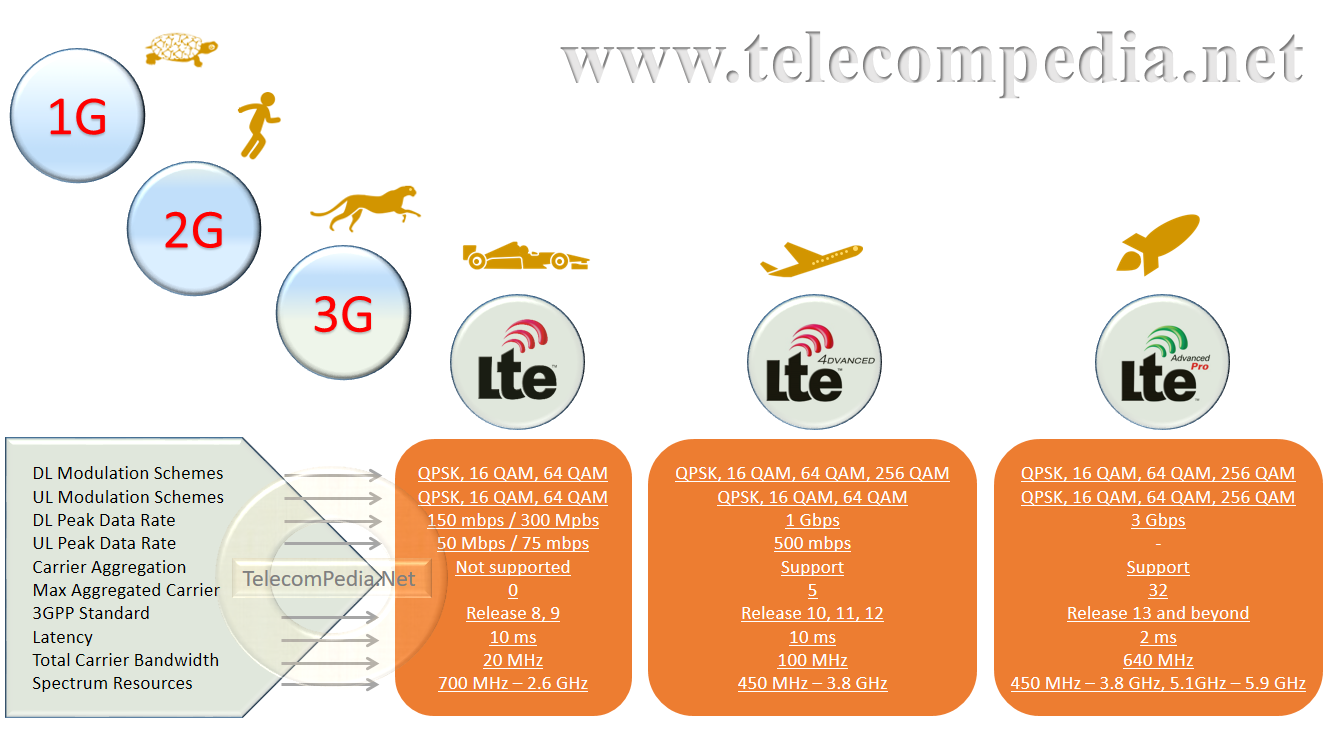Long-Term Evolution or with abbreviated version LTE is a standard for high-speed wireless communication. It is based on the GSM/EDGE and UMTS/HSPA technologies. First step of LTE starts from 3GPP Release 8. Currently we can see three marks of LTE which are separated from each other according to the features and high-speed:
🔘 LTE
🔘 LTE Advanced
🔘 LTE Advanced Pro
LTE starts from 3GPP Release 8.
• LTE has a flat network architecture comparing with legacy networks such as 2G & 3G. It means network elements were minimized and consists of EUTRAN and EPC parts.
• Flat network means that there is no common base station controller like BSC/RNC.
• Flat network architecture is main reason for cost saving, shorter delay and better user experience.
• Bandwidth configuration is flexible, it supports: 1.4 MHz, 3 MHz, 5 MHz, 10 MHz, 15 MHz, 20 MHz.
• Peak downlink data rate can be reached up to 150Mbps with 2 receive antennas at UE side.
• Peak uplink data rate can be achieved up to 50Mbps with using 1 transmit antenna at UE side.
• Most mobile operators are using LTE for packet services but at the same time voice services can be handled by LTE with using traditional networks (2G/3G). To operate voice services CSFB feature is used. If the operators use CSFB feature to handle voice services then IMS network is not required.
• LTE supports voice services with VoLTE, but in this case IMS network need to be deployed.
• OFDMA for downlink and SC-FDMA for uplink multiple access technologies are used for LTE.
• LTE is designed to support both the paired spectrum for FDD and unpaired spectrum for TDD.
• LTE supports flexible spectrum options such as: 2.6 GHz, 1.8 GHz, 800 MHz, 700 MHz and etc…
• LTE supports handover, reselection with legacy network technologies: GSM, UMTS and CDMA.
• QPSK, 16QAM and 64QAM modulation schemes are used for LTE.
• It is possible to make frequency planning with one frequency in LTE network.
• LTE supports MIMO antenna technology for DL direction. MIMO for UL direction is available from 3GPP Release 10.
LTE Advanced starts from 3GPP Release 10.
• LTE Advanced has more advantages than LTE standard. It introduces Carrier Aggregation to provide more throughput. Five carriers can be aggregated in LTE Advanced.
• Theoretical peak downlink data rate can be achieved up to 1Gbps.
• Theoretical peak uplink data rate can be achieved up to 500Mbps.
• 8×8 MIMO in DL direction, 4×4 MIMO in UL direction are available in LTE-Advanced.
• Since 3GPP Release 12, for DL a new 256QAM modulation was intrduced in LTE-Advanced.
LTE Advanced Pro starts from 3GPP Release 13.
• 3GPP has approved a new LTE marker that will be used for the appropriate specifications from Release 13 and it is LTE Advanced Pro.
• The major advances achieved with the completion of LTE Advanced Pro Release 13 include: MTC enhancements, carrier aggregation enhancements, interworking with Wi-Fi, 3D/FD-MIMO, indoor positioning, single cell-point to multi-point and work on latency reduction. Many of these features were started in previous Releases, but will become mature in Release 13.
